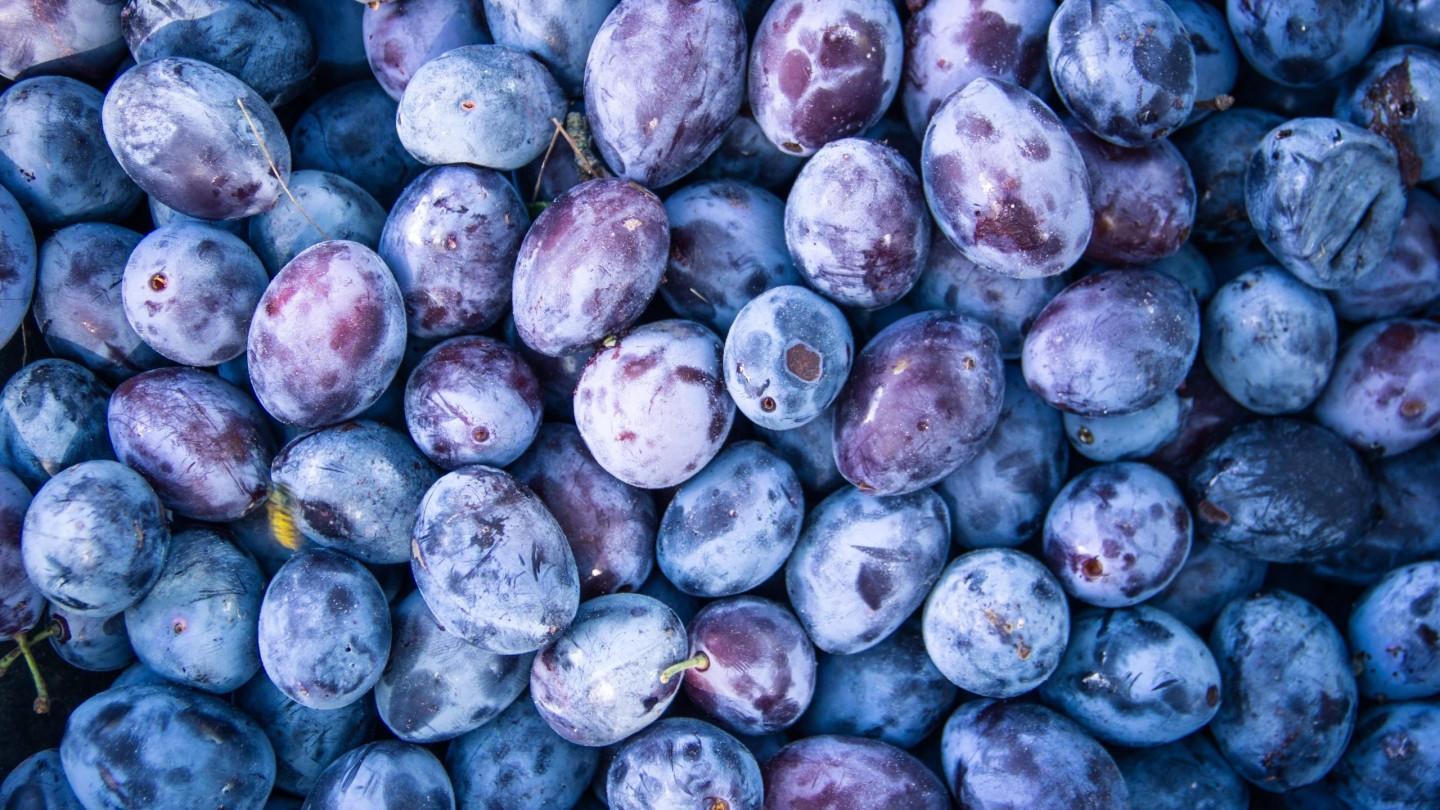
These days are the last chance to get hold of damsons. Those deep purple plums are in a way suggestive of those winter days with their misty frosty appearance, called pruinose, which is reminiscent of frosty windows on a cold day. I’m definitely passionate about these late September purple beauties, and I wonder why we don’t have more of them in our winter provision pantry. With their balanced sourness and sweetness and a spicy, winey backdrop, they provide the ideal taste touch to both sweet and savory dishes. Whether dried into delectable prunes or preserved in other ways, they bring the last of the summer sunshine to the bloomy, dark days of winter. This may explain why many European cuisines are very fond of having something with prunes and plum preserves on their Christmas table.
Dark seduction
Damsons, or purple plums of any variety, have this very appealing color under their veiled pruinose. When cooked, they turn into the most joyful, delicious colors ranging from pink shades to bluish purple with red highlights. This purple brightness is maintained in marmalades and plum preserves; however, they turn almost blackish deep purple when dried or preserved. These purple hues alter depending on both the original plum variety and the cooking method, which usually involves long hours of slow cooking. In German-speaking lands, the Zwetchgenmus, or Pflaumenmus, has a more reddish tint, while Austrian, Hungarian, Polish and other Eastern European plum preserves have that fearful, almost bluish black color. Even the darkest ones have a strange allure, perhaps because the taste of prunes is so seductive for those who like its sweet-sour balance.
Some types of Hungarian or “Szilva lekvár” or Austrian “Powidl” are like a dark mass so thick that they retain their shapes when spooned out. In Budapest markets, I’ve seen them sold, simply weighed on a piece of waxed paper and wrapped, without the need of a container. Traditionally, they are preserved in large earthen jars with handles, called “szilke,” which are filled to the brim with the dark mass. Older generations remember them being stored in wooden crates lined with baking parchment.
Certain regions of Central and Eastern Europe are particularly renowned for their plums and plum products. In Hungary, the plum or “Szilva” address is the Szatmár area. The plum preserve making is also like a communal activity here, with the whole community taking part in cooking the plums in huge cauldrons over an open fire. This slow cooking process takes days and nights, with the young taking turns to stir the plums continuously without a pause, so as not to catch on the bottom of the cauldron. The entire process of plum preserving is one of the most joyful activities of late summer and early autumn. It is also an opportunity to spark love, as boys and girls flirt under the spell of all the smoke and puff of the purple haze of plums.
From Turkish macun to Romanian magiun
All countries in Central and Eastern Europe have a passion for anything associated with plums and prunes. In most of these countries, the plum brandy is among the most popular spirits. The plum preserve of Central Europe is definitely the “Powidl,” also recognized by the regional names of Porvidl, Powidla, Povidla or Podwidel in Austria, Moravia, Bohemia, Czechia and Poland. It is central to many sweets, from baked tarts to boiled dumplings, or fried fritters. How could one imagine the Polish doughnuts Paczki or Austrian Germknödel dumplings without that oozing purple filling?
Among all varieties of plummy tastes, one particular one needs special mention. “Magiun of Topoloveni” in Romania is world-famous and was granted protected geographical indication status by the European Union in 2011. Interestingly, everyone at the NATO bases must now have developed a taste for it, as Romania supplies all bases with the magiun. The town of Topoloveni and the surrounding villages in the Argeş County are where the thick but fine, homogenous paste is produced. The region is known to be home to several plum varieties which give the magiun its distinctive sweet-sour taste with a strong, pleasant aroma. The word “magiun” comes from the Turkish word “macun,” meaning a paste, or in certain cases, fruit preserves. In Cypriot Turkish, for example, a fruit preserve is referred to as “macun,” even if it is not in paste form, but whole fruit preserves. In Ottoman times, it was a term used for all kinds of fruit preserves, so in Romania, it is obviously an Ottoman legacy that has remained in the language, as a food word of the Ottoman past. The passion for purple plums seems to be spreading across a broad territory in the final days of September. So, go and grab some from the market, put them on fire, and you’ll be rewarded in winter!